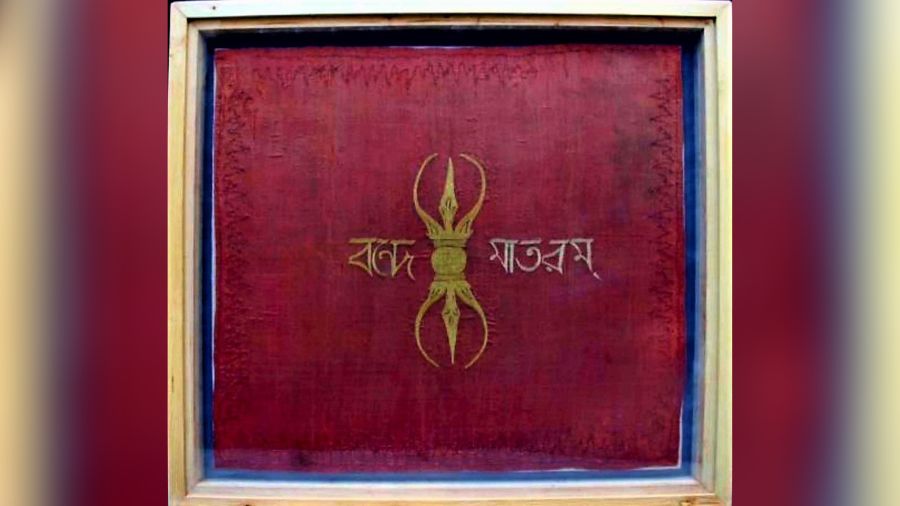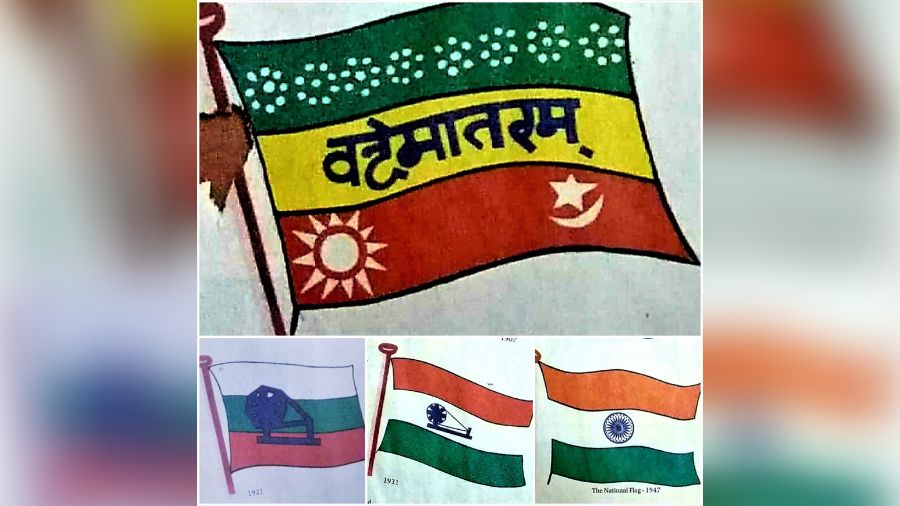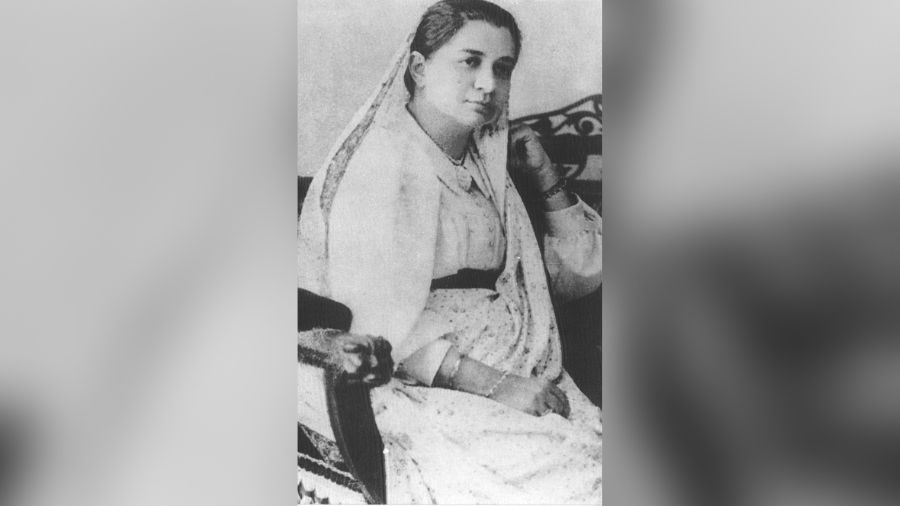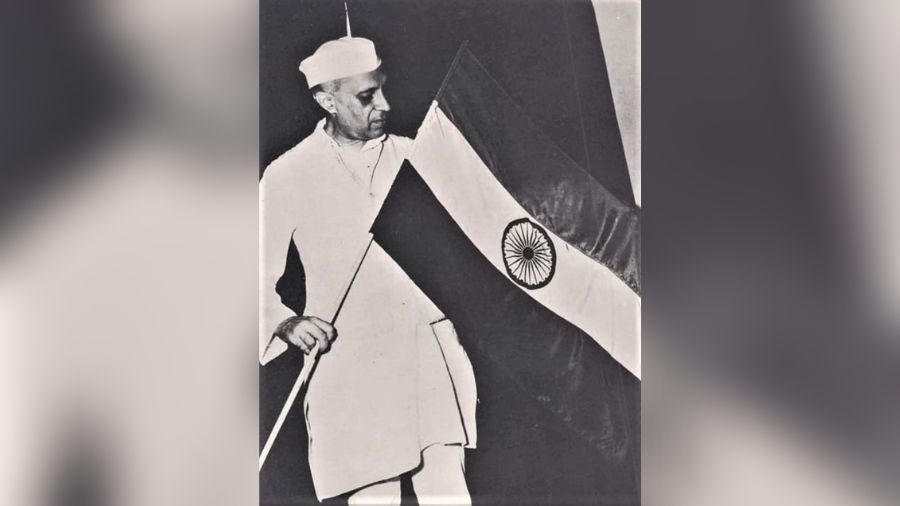For every nation, a national flag is one of the most important symbols of its identity. The design of the national flag — its shape, size, colour and symbols — is often a medium to express the country’s character and what it stands for.
For a long time, India has been under different rulers — from Mughals to the British. In the 200-odd years of British rule, the country did not have a flag of its own. The Union Jack was the flag for India in all international arenas, including in the Olympics between 1928 and 1936. The gold-winning Indian hockey team marched with the flag of Great Britain and saluted it from the podium.
The first flag

The flag designed by Srish Chandra Basu in the 1880s Sekhar Chakrabarti
The first Indian flag was designed in undivided Punjab by a Bengali hailing from UP. Srish Chandra Basu from Allahabad founded the Indian National Society in Lahore, now in Pakistan, in 1883. The organisation designed a flag known as the Swadeshi Pataka, which can be considered as the oldest example of the modern Indian flag. Members of the society used to march with this flag, singing patriotic songs. The flag featured a shining sun at the centre. However, it was not accepted across India.
In 1904, while travelling to Bodh Gaya in the company of people like Rabindranath Tagore, Jagadish Chandra Bose, then editor of The Statesman Arthur Moore, and historian Jadunath Sarkar, Sister Nivedita came across the Vajra symbol of Buddhism. She soon found its reference in Hindu mythology as a weapon of gods, specifically the one wielded by Indra and Durga. In 1909, she published an article in Modern Review titled ‘The Vajra as a national flag’, where she proposed the idea of putting the Vajra symbol on the flag and focused on creating a flag for India. This was perhaps the earliest account of the need for an Indian national flag being expressed in a mainstream magazine.

Sister Nivedita’s flag with the vajra at the centre Sekhar Chakrabarti
In 1905, Sister Nivedita designed a flag on a red surface showing a Vajra with Bande Mataram written in Bengali. It was used in many meetings and rallies during the Partition and also shown in the Calcutta Congress in 1906. Sadly, the idea did not attract any national attention and was soon forgotten.
Though the flag was not popularised in India at the time, it became a topic of discussion at an international flag congress held in 2015 when noted Indian vexillologist Sekhar Chakrabarti delivered a speech on this flag. It revealed the almost unknown history of an Indian flag to many countries.
The Calcutta flag and its evolution
The first flag of India that got pan-Indian acceptance and had also been recognised in Europe was hoisted at a place called Parsi Bagan, where today’s Science College of Calcutta University stands, on August 7, 1906. The flag had three bands in three colours — green on top, yellow in the middle and red at bottom. At the centre, on the strip of yellow, was written Vande Mataram in Devanagari script, while the red strip had a sun and a star with the crescent on two extremes on the red strip. On the topmost green band, there were eight floral motifs depicting lotus petals. It was designed by Sachindranath Bose and Sukumar Mitra. The flag became so popular that in the 1906 Calcutta Congress it was used to decorate the stage replacing the Union Jack. This flag is often considered the first official flag of India.

National flags from 1906 to 1947
It became the first Indian flag to be displayed in an international forum — it was displayed in Stuttgart, Germany, on August 22, 1907, for the International Socialist Congress by two Indians named Madam Bhikaji Cama and Shyamji Krishna Verma.
There is a popular misconception that this flag was designed by Madam Cama and Vinayak Damodar Savarkar. Madam Cama reportedly said that it was given to her by someone languishing in Andaman Cellular Jail. The jailed Indian was Hemchandra Das Kanungo, an Indian nationalist from Midnapore, who went to London to learn how to make bombs from Savarkar and had seen the Calcutta flag of 1906. This flag was later secretly smuggled to British India by a Gujarati man named Indulal Yagnik. It is now in the Maratha museum in Kesari in Pune.

Madam Bhikaji Cama Wikimedia Commons
There were small differences between the flag hoisted in Calcutta and the one displayed by Madam Cama in Germany. In Cama’s flag, the word Vandemataram was written as Vandematar and there was no star above the crescent.
During the Home Rule movement, a new flag was introduced by British lady Annie Besant, and it was used by Lokmanya Tilak and others. Mohammad Ali Jinnah was also in the committee that finalised this new flag. It has red and green stripes, with seven stars representing the Saptarshi constellation, as well as a Union Jack on the poll corner indicating India’s aspiration of dominion status.
The Gandhi flag

Gandhi flag by Pingali Venkayya Sekhar Chakrabarti
From the 1920s, after the death of Tilak, Gandhi became the most powerful leader of the country and his influence was seen everywhere. In 1921, a new flag was adopted by the Indian National Congress and many other organisations where Gandhi was at a position of influence.
A young Telugu man and freedom fighter named Pingali Venkayya met Gandhi and submitted a new design for a flag with red and green. Gandhi suggested that he add white to the mix of colours. This new flag had the three colours and the symbol of the Congress party, the charkha, at the centre. The word Vandemataram was not used at the centre since some communities were not happy with the song. This flag became known as Gandhi flag or Congress flag and was first used in the Vijaywada Congress in 1921 — it dominated the Indian political landscape for the next 10 years.
On June 2, 1931, at the Karachi Congress, a new flag committee was formed with Jawaharlal Nehru, Sardar Patel, Maulana Azad, Pattavi Sitaramaiya, SN Hardikar and others. This committee came up with a flag that is most like the present Indian flag. It had three bands of saffron, white and green with a charkha at the centre. This flag was used in India until 1947.

Nehru with the present-day Indian flag
In July 1947, the flag committee decided to keep the Purna Swaraj flag of 1931 but remove the charkha. Reportedly in 1947, Hindu Mahasabha leader Savarkar sent a telegram to Ambedkar, Rajendra Prasad and Sardar Patel with a note to keep saffron in free India’s flag and also demanded the charkha be replaced with the chakra or “any other symbol signifying progress and strength”.
On July 22, 1947, less than a month before Independence, the Constituent Assembly adopted this flag with Ashoka Chakra at the centre. The change, however, was said to have not gone down well with Gandhi. In an article published in the The Statesman, dated August 6 the same year, he is quoted as having said, “I must say that, if the flag of the Indian Union will not embody the emblem of charkha, I will refuse to salute the flag… the national flag of India was first thought of my me, and I can not conceive of India’s national flag without the emblem of the charkha.”
It is said that Gandhi was under the impression that the Ashoka Chakra, which is taken from the Lion Capital of Ashoka, gives the message of violence. His misconception is said to have been righted by Dr Radhakumud Mukherjee, who met Gandhi at Beliaghata in 1947 to explain to him that Ashoka’s chakra is actually Buddha’s Dharma Chakra, which is inspired from Vishnu’s Sudarshan Chakra. The knowledge is believed to have impressed Gandhi, who then accepted the new flag.
This article is based on the writer’s many discussions with vexillologist Sekhar Chakrabarti
